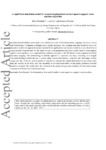A rapid flood inundation model for hazard mapping based on least squares support vector machine regression

Use este enlace para citar
http://hdl.handle.net/2183/35170Coleccións
- Investigación (ETSECCP) [826]
Metadatos
Mostrar o rexistro completo do ítemTítulo
A rapid flood inundation model for hazard mapping based on least squares support vector machine regressionData
2019Centro/Dpto/Entidade
Enxeñaría da Auga e do Medio Ambiente (GEAMA)Cita bibliográfica
Bermúdez, M., Cea, L., & Puertas, J. (2019). A rapid flood inundation model for hazard mapping based on least squares support vector machine regression. Journal of Flood Risk Management, 12, e12522. https://doi.org/10.1111/jfr3.12522
Resumo
[Abstract:] Two-dimensional shallow water models are widely used tools for flood inundation mapping. However, even if High Performance Computing techniques have greatly decreased the computational time needed to run a 2D inundation model, this approach remains unsuitable for applications that require results in a very short time or a large number of model runs. In this paper we test a non-parametric regression model based on least squares support vector machines as a computationally efficient surrogate of the 2D shallow water equations for flood inundation mapping. The methodology is initially applied to a synthetic case study consisting of a straight river reach flowing towards the sea. A coastal urban area is then used as a real test case. Discharge in three streams and tide levels are used as predictor variables to estimate the spatial distribution of maximum water depth and velocity in the study area. The suitability of this regression model for the spatial prediction of flood hazard is evaluated. The results show the potential of the proposed regression technique for fast and accurate computation of flood extent and hazard maps.
Palabras chave
Flood hazard
Flood inundation
Iber model
Shallow water equations
Support vector machine
Flood inundation
Iber model
Shallow water equations
Support vector machine
Descrición
Versión aceptada de https://doi.org/10.1111/jfr3.12522





